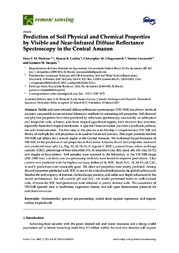Prediction of soil physical and chemical properties by visible and near-infrared diffuse reflectance spectroscopy in the Central Amazon.
Prediction of soil physical and chemical properties by visible and near-infrared diffuse reflectance spectroscopy in the Central Amazon.
Autoria: PINHEIRO, E. F. M.; CEDDIA, M. B.; CLINGENSMITH, C. M.; GRUNWALD, S.; VASQUES, G. de M.
Resumo: Visible and near-infrared diffuse reflectance spectroscopy (VIS-NIR) has shown levels of accuracy comparable to conventional laboratory methods for estimating soil properties. Soil chemical and physical properties have been predicted by reflectance spectroscopy successfully on subtropical and temperate soils, whereas soils from tropical agro-forest regions have received less attention, especially those from tropical rainforests. A spectral characterization provides a proficient pathway for soil characterization. The first step in this process is to develop a comprehensive VIS-NIR soil library of multiple key soil properties to be used in future soil surveys. This paper presents the first VIS-NIR soil library for a remote region in the Central Amazon. We evaluated the performance of VIS-NIR for the prediction of soil properties in the Central Amazon, Brazil. Soil properties measured and predicted were: pH, Ca, Mg, Al, H, H+Al, P, organic C (SOC), sum of bases, cation exchange capacity (CEC), percentage of base saturation (V), Al saturation (m), clay, sand, silt, silt/clay (S/C), and degree of flocculation. Soil samples were scanned in the laboratory in the VIS-NIR range (350-2500 nm), and forty-one pre-processing methods were tested to improve predictions. Clay content was predicted with the highest accuracy, followed by SOC. Sand, S/C, H, Al, H+Al, CEC, m and V predictions were reasonably good. The other soil properties were poorly predicted. Among the soil properties predicted well, SOC is one of the critical soil indicators in the global carbon cycle. Besides the soil property of interest, the landscape position, soil order and depth influenced in the model performance. For silt content, pH and S/C, the model performed better in well-drained soils, whereas for SOC best predictions were obtained in poorly drained soils. The association of VIS-NIR spectral data to landforms, vegetation classes, and soil types demonstrate potential for soil characterization.
Ano de publicação: 2017
Tipo de publicação: Artigo de periódico
Unidade: Embrapa Solos
Palavras-chave: Carbono orgânico do solo, Pré-processamento espectral, Quimiometria, Solos tropicais
Observações
1 - Por padrão são exibidas publicações dos últimos 20 anos. Para encontrar publicações mais antigas, configure o filtro ano de publicação, colocando o ano a partir do qual você deseja encontrar publicações. O filtro está na coluna da esquerda na busca acima.
2 - Para ler algumas publicações da Embrapa (apenas as que estão em formato ePub), é necessário ter, no celular ou computador, um desses softwares gratuitos. Sistemas Android: Google Play Livros; IOS: iBooks; Windows e Linux: software Calibre.
Acesse outras publicações
Acesse a Base de Dados da Pesquisa Agropecuária (BDPA) para consultar o acervo completo das bibliotecas da Embrapa.

